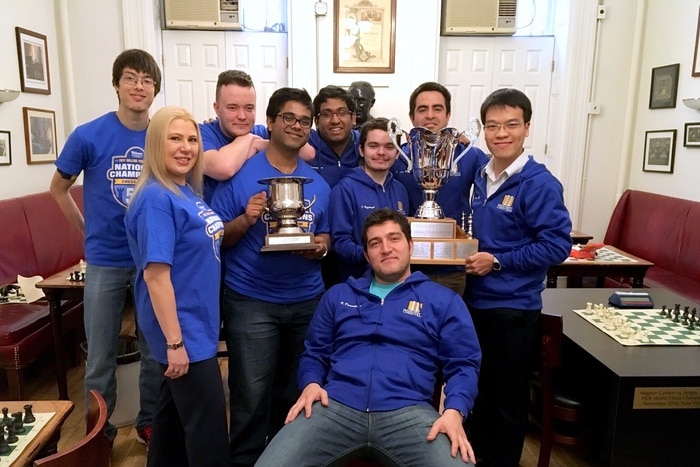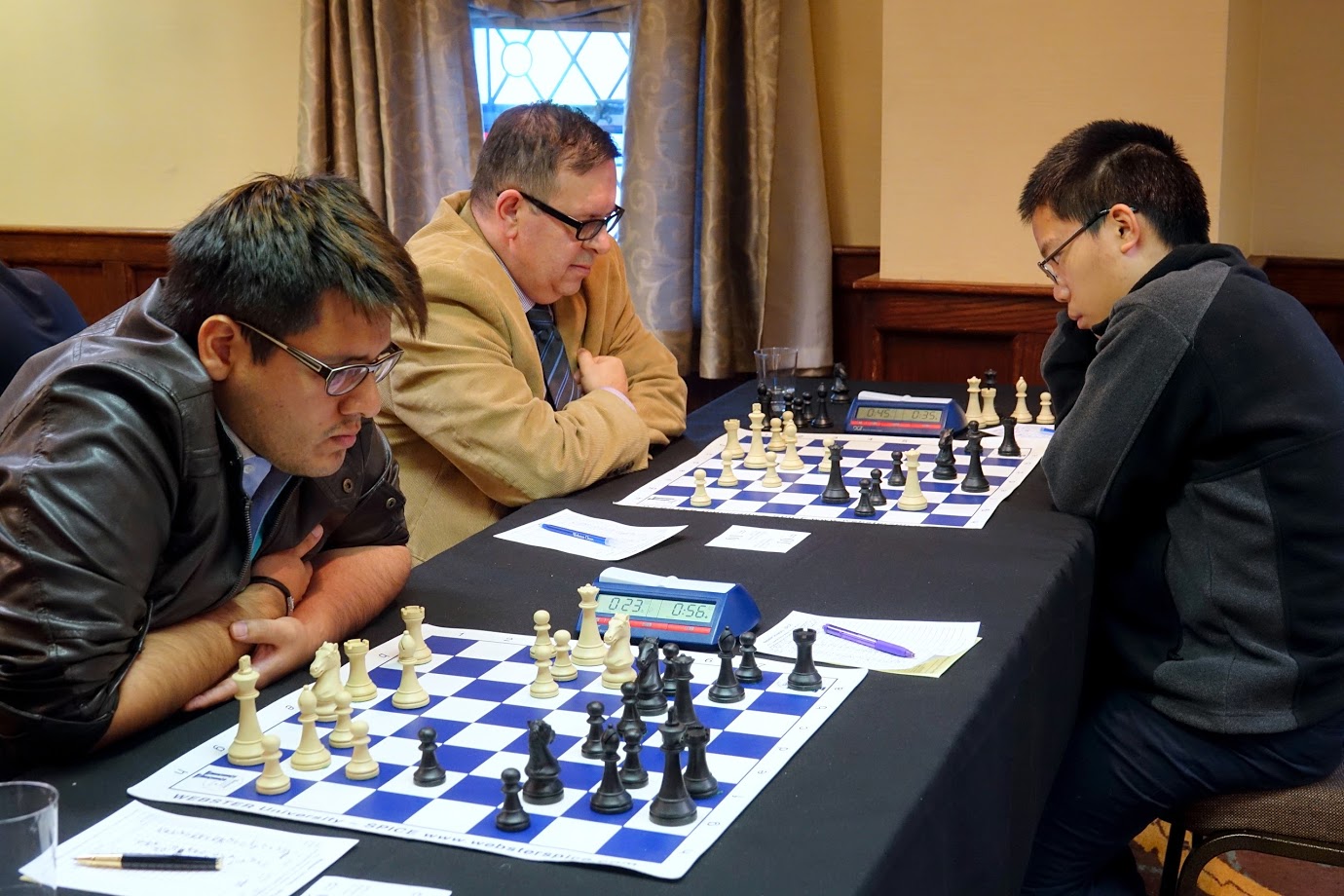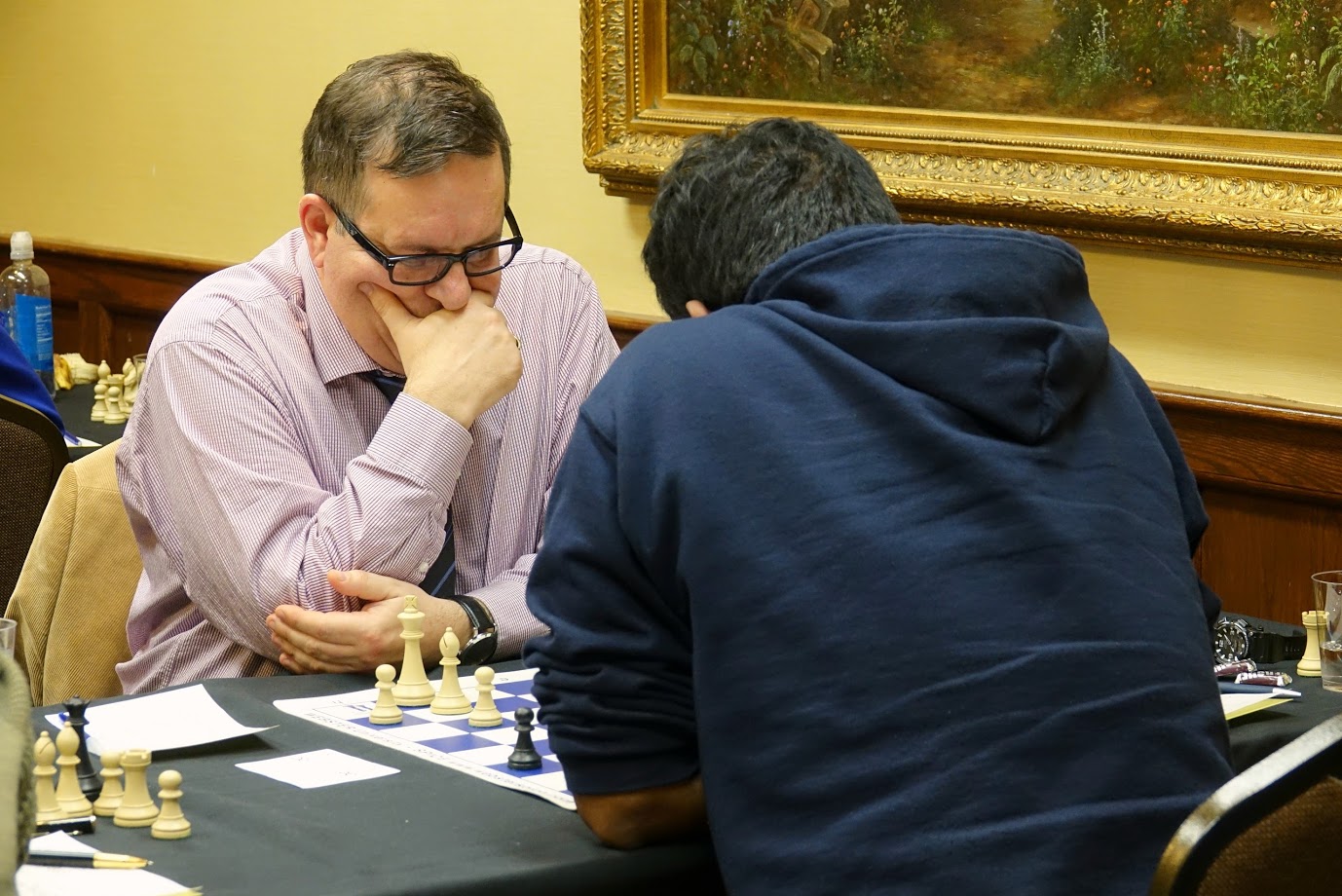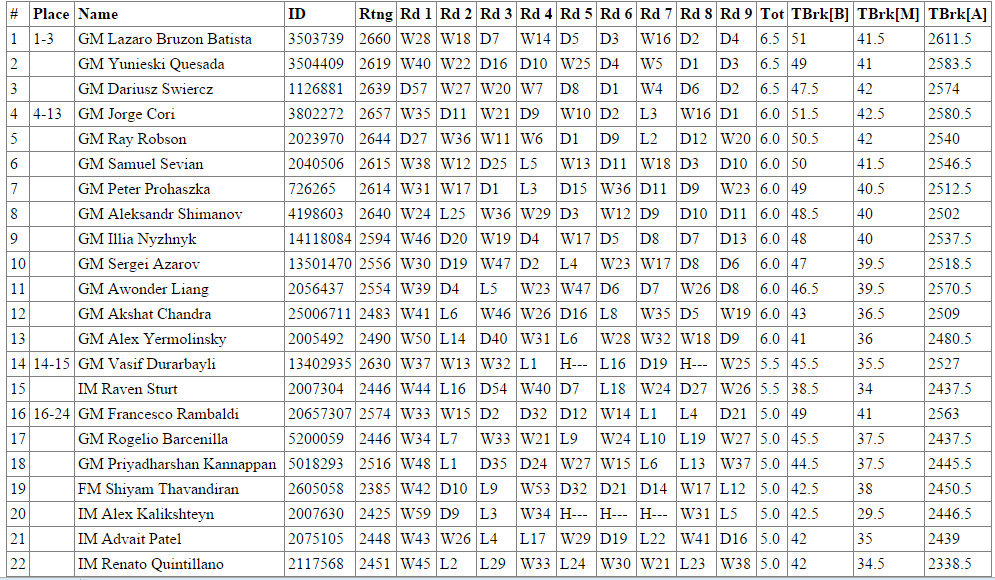A half point back
The 11th Annual Spice Cup attracted 61 players from 19 countries, including 21 Grandmasters, 6 International Masters and one Women Grandmaster. The traditional event is sponsored by Webster University, the host of the strongest program in American Collegiate chess. Headed by Susan Polgar, the Webster Team boasts international stars from all over the world and they have won the National Championship seven years in a row.

Back row (l to r): Ray Robson, Alex Shimanov, Priyadharshan Kannapan, Manuel Leon Hoyos; front row (l to r) Susan Polgar, Ashwin Jayaram, Illia Nyzhnyk, Le Quang Liem. Manspreading in the foreground: Vasif Durarbayli | Photo: Paul Truong
Things aren't looking to be easier for the competition in the upcoming years, as Webster has recently added Peruvian star Jorge Cori and Hungary's Peter Prohaszka, with more talent still on the waiting list.
There is no question that for many a young chessplayer coming to St. Louis to pursue college education while honing their chess skills not only represents an attractive option but is also a great opportunity. I wish the best of luck to all future applicants, but, <disclaimer> please, do not contact the author of this article with inquiries, as I am not in any shape or form associated with the Webster University Chess Program.
I really like playing in the Spice Cup. There are many advantages: a restricted number of players, therefore no overcrowding; a strong field to provide challenging competition; a comfortable game in 90 minutes time control, and a very nice location.

The excellent venue: the Clayton Plaza Hotel | Photo: Alex Yermolinsky
The city of Clayton just borders St. Louis proper from the west, and it's known for its highly educated and prosperous population of some 15 thousand people, many of whom reside in buildings such as this one.

The elegant, high quality housing in Clayton, where daily walks with the wife did wonders for morale | Photo: Alex Yermolinsky
My wife Camilla accompanied me to the Spice Cup for the first time, and while her own result in the tournament could have been better, her help and support were instrumental in my good performance. We enjoyed our walks on the quiet streets of Clayton, with our usual destination being this one:

Ye Olde Coffeehouse | Photo: Alex Yermolinsky
I had a bit of a shaky start: A second round loss to Vasif Durarbayli in 23 moves with white was a game to forget, but gradually I played myself into some kind of form. Ironically, it took another loss, to Sam Sevian, to really get me going, but what a game it was.
Sam Sevian 1-0 Alex Yermolinksy
Before you delve into the game. Take a look at this position and see what you can find.
Sevian has really come around as a mature player in 2017. The track record says it all. In the spring he shared first place in three events: the Southwest Class Championship, the Philadelphia Open and the Eastern Class Championship.
It was just a start. Having warmed up a bit, the 17-year-old then outright won the Spring Chess Classic Round-Robin (Group C) in St. Louis, and one of the largest Swiss tournaments in the U.S. Circuit, the Chicago Open.

Sam Sevian has had a superb 2017 | Photo: Paul Truong
This great run culminated in winning the American Continental Championship in Medellin, Columbia in June. Later in the summer Sam distinguished himself with a solid performance at the World Cup in Tbilisi.

[Event "Spice Cup"] [Site "St. Louis"] [Date "2017.10.23"] [Round "5"] [White "Sevian, Sam"] [Black "Yermolinsky, Alex"] [Result "1-0"] [ECO "B33"] [WhiteElo "2615"] [BlackElo "2490"] [Annotator "Alex Yermolinsky"] [PlyCount "123"] [EventDate "2017.??.??"] 1. e4 c5 2. Nf3 Nc6 3. d4 cxd4 4. Nxd4 Qb6 {I played this sideline a lot in the past. It seemed like a good idea to give an unusual twist to known Scheveningen structures. The point is to drive the white knight away from the center at the cost of losing some time on the extra queen move} 5. Nb3 Nf6 6. Nc3 e6 7. Qe2 $5 {A popular choice among the numerous English Attack devotees. I had faced it against Mickey Adams and Ray Robson.} Bb4 $5 {I have always preferred this move} ({to the standard} 7... d6 8. g4) 8. Bd2 O-O 9. a3 Be7 $1 10. Be3 (10. e5 {is answered by the somewhat surprising} Nd5 $1 {where the absence of white major pieces from the d-file allows Black the time to undouble the pawns. Adams-Yermolinsky, World Championship KO, New Delhi 2000 went} 11. O-O-O d6 12. exd6 Bxd6 13. g3 Be5 14. Nxd5 exd5 {Two things seemed obvious to me at this moment of the game: Black must play a7-a5 quick to generate threats, and White's Be3 is always answered by d5-d4.}) ({Not much different is the other move order:} 10. O-O-O d5 11. Be3 Qc7 12. exd5 Nxd5 13. Nxd5 exd5 {was Robson-Yermolinsky, US Championship 2010}) 10... Qc7 11. f4 { This is a different concept. White wants to close the center.} d5 12. e5 Nd7 { [#] The resulting pawn structure is nothing new, we get it from the Classical Steinitz French. There are some minor details though. The White knight is way from d4, so usual defensive plans based on exchanging pieces aren't available. Instead Black may try for f7-f6. Also the white queen blocks her own bishop, so Sevian's next move attempts to take care of both problems.} 13. Qg4 $5 { An ambitious move from an ambitious player.} ({Previously known was} 13. Nb5 Qb8 14. O-O-O {where Black absolutely must strike in the center with} f6 $1 ({ instead of the meek} 14... a6 15. N5d4 Nc5 16. Kb1 $14) 15. exf6 Nxf6 {seeking further complications after} 16. Kb1 e5) 13... b6 14. Bb5 $5 {An interesting idea to establish the control of the d4-square.} Nc5 ({During the game I considered} 14... a6 15. Bxc6 Qxc6 16. Nd4 Qc4 17. Nxe6 {dangerous for Black. Now I can see that after} fxe6 18. Qxe6+ Rf7 19. Nxd5 Bh4+ $1 20. g3 Qxc2 { it can go both ways.}) 15. Nd4 Nxd4 16. Bxd4 f5 {I felt obliged to secure my king.} (16... Ba6 17. Bxa6 Nxa6 18. O-O-O {and White aims for an attack with f4-f5.}) 17. Qh3 Ne4 18. O-O Bc5 $6 {Possibly a mistake, as later I realized I cannot trade the light-squared bishops with my knight on the board.} (18... Bd7 19. Bd3 Nxc3 20. bxc3 Bc5 {would have been roughly equal.}) 19. Ne2 a5 20. Qe3 Bd7 {Change of plans.} (20... Ba6 21. Bd3 $1 a4 22. Rac1 {and with his queenside secure White can now think of g2-g4, albeit his advantage is very small.}) 21. Bd3 Rfc8 22. Rac1 {Threatening c2-c4. That's what happens when f7-f5 makes the e6-pawn weak.} b5 23. Bxe4 fxe4 (23... dxe4 24. Bxc5 Qxc5 25. Qxc5 Rxc5 26. Rfd1 {clearly in White's favor.}) 24. c3 Be7 25. g4 Rf8 26. Ng3 Bh4 ({I could have slowed down his f4-f5 by just playing} 26... h6) 27. Nh5 Be8 28. Qh3 Bxh5 {[#]} 29. Qxh4 $1 {Sam was absolutely correct with this decision.} ({Not so good for him was} 29. gxh5 Qe7 30. Kh1 (30. Rc2 Rf5 31. Qg4 Bg5 $1 {is one fine point. When the bishop gets to h6 it'll play important roles in both attack and defense.}) 30... Rf5 31. Qg4 Raf8 32. b4 axb4 33. axb4 Qd8 34. Rg1 R8f7 {appeared very safe to me.}) 29... Bg6 30. Rf2 Qc4 {From this point to the end of the game I played on the increment alone. In such situations one must counterattack or at least bother the opponent with some threats. I have learned this much from a lifetime of playing the Sicilian.} (30... b4 {I rejected on account of} 31. axb4 axb4 32. Qg5 {but there was a nice defensive idea I failed to consider:} Ra6 $1 {and White cannot yet go} 33. f5 exf5 34. gxf5 {because of} Bxf5 $1 35. Rxf5 Rg6) 31. Re1 Qd3 32. Re3 Qb1+ 33. Kg2 h6 { So I got my queen in and managed to stop White's intended Qg5.} 34. h3 $6 { Some hesitation from Sam, both on the board and the clock.} (34. Qe7 Rfe8 35. Qd7 b4 36. f5 {would force me to defend with} Bf7 $14) 34... b4 $1 {An important step forward. Black needs to open a file for his rook to give his active queen some support.} 35. Qe7 bxa3 36. bxa3 (36. Qxe6+ $2 Bf7 37. Qd6 a2) ({Possibly} 36. Qxa3 Rab8 37. Qd6 Bf7 38. Ree2 {was a better choice.}) 36... Rfe8 {I actually felt quite good about my chances.} 37. Qh4 {[#]} Rf8 {but soon I realized I had to repeat.} ({The thing is,} 37... Rab8 38. f5 Qd1 { is a nice counterattack, but Black is only playing for a draw.} 39. fxg6 Rb1 40. Kg3 Qg1+ (40... Qh1 {gets destroyed by} 41. Qf6 $3 (41. Bc5 a4 {and both sides are stuck, with no improvement in sight.}) 41... gxf6 42. exf6 Qg1+ ( 42... Rg1+ 43. Kh4) 43. Rg2 Qf1 44. f7+ Kf8 45. fxe8=Q+ Kxe8 46. g7 Qf7 47. Ree2 {and White calmly brings his rook to f8.}) 41. Rg2 Qh1 42. g5 Rf1 43. Qg4 Rf5 44. gxh6 gxh6 45. Rh2 Qg1+ 46. Rg2 {being one of the lines that end peacefully.}) 38. Qe7 Rfe8 39. Qd7 Rad8 40. Qa4 $5 {Sevian shows his tremendous fighting spirit.} Rb8 41. f5 (41. c4 dxc4 42. Qxc4 Rbc8 {and facing the threat of Rc1 White has to retreat to the endgame} 43. Qa2 Qxa2 44. Rxa2 $11) 41... exf5 42. Qd7 $2 {It is hard to criticize the players for losing their precision in time trouble.} ({Truth to tell, the objectively best} 42. gxf5 Bh5 43. Qc2 Bf3+ 44. Rexf3 exf3+ 45. Kxf3 {is hardly a winning attempt.}) 42... Rbd8 (42... fxg4 43. e6 Rb7 $1 {I missed that one.} ({I thought} 43... Qb7 {was my only defense, and panicked when I saw} 44. Rf7 $1 {In reality,} Qxd7 45. Rxd7 Rb2+ 46. Kg3 (46. Kg1 Rxe6 47. Rxg7+ Kf8 48. hxg4 $11) 46... gxh3 {is totally fine for Black. This mistake and some others that eventually cost me this game can be explained by my lack of practice playing on the increment. With only 30 seconds left per move one has to trust his intuition more. Instead, I was calculating as hard as I could and then had to play a move before I was able to get to the end of my lines.}) 44. Qxd5 gxh3+ 45. Rxh3 e3 46. Rxe3 Rb5 {and Black is the one attacking.}) 43. Qc6 Kh7 44. gxf5 Bh5 45. Rf1 $6 (45. Kh2 $1 Bf3 46. Qg6+ Kg8 47. Rexf3 exf3 48. Rxf3 $16) 45... Qa2+ 46. Kg3 Rc8 {I knew I had to hit something with every move.} (46... Qxa3 $2 47. f6) 47. Qd6 Rcd8 48. Qa6 Ra8 49. Qc6 Rac8 50. Qd7 Rcd8 51. Qa4 $5 {For the second time around Sam makes a very brave decision to avoid repetition.} Bf3 52. Rfxf3 exf3 53. Rxf3 Qd2 54. Qc6 Qg5+ 55. Kh2 Rb8 56. c4 {Suddenly the bishop covers b2.} dxc4 (56... Qd2+ {does nothing:} 57. Bf2) 57. Qe4 {[#]} Kh8 $2 ({First I looked at} 57... Rb3 {and thought I was losing after} 58. f6+ Qg6 59. Qxg6+ Kxg6 60. f7 Rf8 61. Rxb3 cxb3 62. e6 {To my tired eyes it seemed that Black is helpless, but} Rxf7 63. exf7 Kxf7 {is actually a simple draw:} 64. Kg3 g5 65. Kf3 (65. a4 Kg6) 65... h5 66. Ke4 g4 67. h4 a4) ({I didn't have time to consider other moves. Among them} 57... Qd2+ 58. Bf2 (58. Rf2 Qd3 59. Qg4 Rbd8 60. Rg2 Rg8 {forcing the bishop off the long diagonal before e5-e6 is played.}) 58... Kh8 59. f6 Rf8 {was a legitimate winning attempt, but finding such cool moves under extreme pressure from the clock is above my current pay grade.}) 58. Rg3 Qd2+ $2 {The second mistake loses.} (58... Qc1 59. e6 Rb2+ 60. Bxb2 Qxb2+ 61. Rg2 $11) 59. Rg2 Qd3 60. Qg4 Rg8 61. e6 {Too late now.} Rb7 62. f6 1-0
The Sicilian has been known for decades as the most reliable way for Black to obtain an unbalanced but good position. Among the most popular Sicilians at the top level the two that certainly stand out are the Najdorf and the Paulsen.
Despite the bad finish I really enjoyed this game, and even losing it didn't hurt much. If anything, keeping pace with Sam Sevian for almost 30 moves of mutual time trouble instilled some confidence in me. It paid off immediately as I finished with 3½/4 and managed to join Sam and others in a large tie for equal 4th place.
This is how I did it.
Alex Yermolinsky 1-0 Ruifeng Li
The 16-year old Ruifeng Li has long been in the shadow of his friend Jeffery Xiong. They both come from the Lone Star State, and bright stars they truly are. Ruifeng had a breakthrough year in 2016 when he raised his rating over 100 points to reach the respectable 2580 mark. This year so far has been a bit of a setback (ironically the same goes for Xiong), but, I'm sure it's just growing pains.

When experience outweighs youth, Yermolinksy vs Ruifeng | Photo: Paul Truong
In my preparation I noticed that lately Ruifeng has been a bit too eager to obtain fighting positions with Black, often to the detriment of safety. Our game followed the same script.

[Event "Spice Cup"] [Site "?"] [Date "2017.10.25"] [Round "7"] [White "Yermolinsky, Alex"] [Black "Li, Ruifeng"] [Result "1-0"] [ECO "D43"] [WhiteElo "2490"] [BlackElo "2570"] [Annotator "Yermo"] [PlyCount "93"] [EventDate "2017.??.??"] 1. Nf3 Nf6 2. c4 e6 3. Nc3 d5 4. d4 c6 5. Bg5 h6 6. Bxf6 Qxf6 7. Qb3 Qe7 $5 { This move is the latest addition to a list of known options.} (7... Nd7 8. e4 dxe4 9. Nxe4 Qf4 10. Bd3 {was the World Cup winning game in the Aronian-Ding Liren match.}) (7... a5 8. e3 a4 {Navara-Ding Liren, Blitz 2016}) (7... dxc4 8. Qxc4 Nd7 9. Rd1 {Akobian-Shankland, US Championship 2017.}) 8. e4 {I didn't hesitate much on this one. The main theme of the Moscow Variation is to push e2-e4 in one move.} g6 $5 {A novelty.} ({Naturally,} 8... dxe4 9. Nxe4 Qb4+ { is the most solid reply.} 10. Nc3 ({I thought of a strange possibility of} 10. Kd1 {that got me thinking about early king's moves. Soon you will see what came out of that idle speculation.}) 10... Qxb3 11. axb3 g5 { Sargissian-Karjakin, World Team Championship 2015.}) 9. exd5 {I just couldn't resist the temptation.} ({Both} 9. e5) ({and} 9. Bd3 {were normal, solid choices.}) 9... exd5+ 10. Kd2 $5 {[#] Here it is, I move my king.} Bg7 $2 { Ruifeng spent some time on this one, but it follows the main line of my calculations.} ({Instead, the best answer was to sac a pawn:} 10... Qd6 $1 { to complete his development with} 11. cxd5 Be7 12. Bd3 O-O 13. Rae1 Kg7 $1 ( 13... Rd8 {allows some unnecessary fireworks:} 14. Bxg6 $1 {etc.}) 14. Kc2 cxd5 15. Qxd5 Rd8 {Black isn't risking much in this situation.}) 11. Re1 Be6 12. cxd5 cxd5 13. Nxd5 Qd6 {Black must take away that f4-square.} (13... Qd7 $2 14. Nf4 $18) 14. Rxe6+ $6 {"Everything is proceeding as I have foreseen" to quote Emperor Palpatine. We all know where it got him.} ({The engines show the right path:} 14. Qxb7 O-O 15. Rxe6 fxe6 16. Ne7+ $1 ({I only saw} 16. Qxa8 exd5 { which is highly unclear.}) 16... Kf7 17. Qxa8 Qxe7 18. Bd3 {is easily winning for White.}) 14... fxe6 15. Qxb7 Qxd5 16. Qxg7 Rf8 {[#] This is the position I had in mind before embarking on this whole thing. Contrary to my great expectations, it isn't so decisively winning for White.} 17. Bd3 {I figured getting my pieces out was more important than gorging on the pawns.} ({ although,} 17. Qxg6+ Ke7 18. Qxh6 Nd7 19. Bd3 Qxa2 20. Qg5+ Kd6 21. Ke3 { doesn't look too bad for White.}) 17... Nd7 18. Rc1 {I saw the following exchange sacrifice coming and hoped to keep my advantage.} ({The alternative,} 18. Ke3 {would allow Black to intercept the c-file.} Rc8 19. Bxg6+ Kd8 20. Ne5 Rc7 $16 21. Nxd7 $2 Qg5+) 18... Rxf3 $1 19. gxf3 Qg5+ 20. f4 Qxf4+ 21. Kd1 Qxf2 {[#] Amazingly, I couldn't see a clean path to victory.} 22. Qxh6 {Finally I settled on a line that leads to further simplifications.} (22. Bxg6+ Kd8 23. Qg8+ Nf8 24. Bd3) (22. Rc3 $5) 22... Qxd4 23. Qxg6+ Ke7 24. Rc4 Qxb2 25. Qh7+ Kd6 26. Qe4 Rh8 27. Rc6+ Ke7 28. Rxe6+ Kd8 29. Qa8+ {Bailing out too soon.} ( 29. h4 $1 Qa1+ (29... Kc7 30. Qd5) 30. Bb1 Qb2 31. Qa8+ Qb8 32. Qxb8+ Nxb8 33. Re4 $16) 29... Qb8 30. Qxb8+ Nxb8 31. Re2 {Under normal circumstances Black should be able to hold, but Ruifeng misjudged the upcoming minor piece ending.} Kc7 $6 (31... Nc6 $14) 32. Re7+ Kd6 33. Rh7 Rxh7 $2 (33... Rg8 $1) 34. Bxh7 { [#] This position may seem drawish based on one dangerous assumption that Black is going to be able to give his knight for the a-pawn. In my experience, it is not always the case. Fischer-Taimanov, Candidates Match (2), Vancouver 1971 comes to mind first, and then I had a similar endgame against Pavel Blatny in the 2002 National Open.} Nc6 35. Kd2 Ke5 ({There is a defensive plan of assigning the knight the duty of stopping the h-pawn and keeping the king in the center to impede the progress of the white king:} 35... Nb4 36. a3 Nd5 37. h4 Ke5 38. Kd3 Nf6 39. Bg6 Kd5 40. h5 Ng4 41. Kc3 Kc5 42. Kb3 Kb5 {[#] but then White will operate with Zugzwangs:} 43. Bf5 Nh6 44. Be6 $1 a5 (44... Ka5 45. Kc4 Ka4 46. Kd4 Kxa3 47. Ke5 Kb4 48. Kf6 Kc5 49. Kg5 Kd6 50. Ba2 Ke7 51. Kxh6 $18) (44... Kc5 45. Ka4 Kb6 46. Kb4 a6 47. a4 a5+ 48. Kc4 Kc6 49. Bd5+ Kd6 50. Bf3 Nf5 51. Be4 Nh6 52. Kb5 $18) 45. Kc3 Kc5 46. Kd3 Kd6 47. Bb3 Ng4 48. Kc4) 36. Kc3 Kf4 37. Bg8 a5 $2 {This only makes White's task easier.} 38. Kc4 Nb4 39. a4 Kg4 40. Be6+ Kh4 {[#]} 41. Kd4 $18 {Clearing out the c4-square for the bishop.} Nc2+ 42. Kc5 Nb4 43. Bc4 {Total domination: d5, d3 and a2-squares all have been taken away from the hapless knight.} Nc2 44. Kb6 Ne3 45. Bb3 Nf1 46. Kxa5 Nxh2 47. Kb6 1-0
The positional exchange sacrifice is one of the most powerful and fascinating strategic weapons in chess. On this DVD Sergey Tiviakov explains why the positional exchange sacrifice is such a strong weapon and how to use it.
Alex Yermolinksy 1-0 Priyadharshan Kannappan

A first encounter between Yermolinsky and Priyadarshan | Photo: Paul Truong
This was our first encounter at the chessboard, but I have seen Priyadh at many tournaments. One thing has always confused me, as is often the case with players from India, and that is under which name he might be listed.
In the U.S. Chess Federation databases he goes by Priyadharshan (first name) Kannappan (last name), but ChessBase knows him as the other way around! I'd assume the USCF way is correct, just out of the similarity with other Indian players' names. A clarification from a knowledgeable source would be much appreciated.

[Event "Spice Cup"] [Site "?"] [Date "2017.10.25"] [Round "8"] [White "Yermolinsky, Alex"] [Black "Kannappan, Priyadharshan"] [Result "1-0"] [ECO "A39"] [WhiteElo "2490"] [BlackElo "2516"] [Annotator "Yermo"] [PlyCount "125"] [EventDate "2017.??.??"] 1. Nf3 Nf6 2. c4 c5 3. Nc3 Nc6 4. g3 g6 5. Bg2 Bg7 6. O-O O-O 7. d4 cxd4 8. Nxd4 Qa5 9. Nb3 Qh5 10. Nd5 d6 11. Nf4 {Inspired by the recent game Grischuk-Navara} Qf5 $1 12. e4 Qd7 (12... Nxe4 13. g4 Qe5 14. Re1) 13. Qe2 b6 14. Be3 Ba6 15. Rfd1 Rac8 16. Rac1 Rfd8 $6 {One of those do-nothing moves.} ({ Much stronger was} 16... Ne5 17. Nd2 e6 {and the white knights are a bit out of position for a standard Maroczy Bind play.}) 17. Nd4 e5 ({I expected} 17... Ne5 {where White should avoid the temptation of winning the exchange with} 18. Bh3 (18. b3 e6 19. f3 $14) {as} 18... Qb7 19. Bxc8 Rxc8 20. b3 Qxe4 21. f3 Qa8 {would provide Black with ample compensation.}) 18. Nxc6 Qxc6 (18... exf4 $2 19. e5 Ne8 20. Nxd8 fxe3 21. Nxf7) 19. Nd5 Nxd5 20. exd5 Qe8 (20... Bxc4 $2 21. Qg4 Qb5 22. b3 f5 23. bxc4) 21. b3 f5 {Draw offer} 22. a4 Rb8 23. Qd2 Bc8 24. a5 bxa5 25. Qxa5 Rxb3 (25... f4 26. gxf4 Bg4 27. Re1 Qf7 28. fxe5 Bxe5 29. c5) 26. Bg5 Rd7 27. c5 h6 (27... dxc5 28. d6 Bb7 29. Qa2 (29. Bf1 $1 Rb2 30. Bc4+ Kh8 31. Qxc5 $16) 29... Qe6 30. Bxb7 Rdxb7 31. d7 Rxd7 32. Rxd7 Rxg3+ 33. hxg3 Qxa2 34. Rxc5 Bf8 35. Rd8) 28. c6 Rf7 29. Qd8 Qxd8 30. Bxd8 Bf6 31. Bxf6 Rxf6 32. Rb1 Rxb1 33. Rxb1 Rf7 34. f4 exf4 35. gxf4 Rc7 36. h4 Kf7 37. Kf2 Kf6 38. Kg3 Re7 39. Rb8 Rc7 40. Bf1 Kg7 41. Bd3 Kf6 42. Ra8 Kg7 43. Rb8 Kf6 44. Kf3 Ke7 $2 45. h5 $18 gxh5 (45... g5 46. fxg5 hxg5 47. h6 Kf6 48. h7 Rxh7 49. Rxc8 Ke5 50. Kg2 Kxd5 51. Bxf5 Re7 52. Bd7) 46. Kg3 Kf6 47. Kh4 Kg6 48. Ra8 Kf6 49. Kxh5 Kg7 50. Rb8 Kf6 51. Bc2 Kg7 52. Ra8 Kf6 53. Kxh6 a5 54. Ba4 Ke7 55. Kg5 Kd8 56. Bc2 Rg7+ 57. Kf6 Rg8 58. Kf7 Rh8 59. Bxf5 Kc7 60. Bxc8 Rxc8 61. Rxa5 Kb6 62. Ra1 Kc5 63. Rd1 1-0
Williams main teaching method behind this set of two DVDs is to teach you some simple yet effective set ups, without the need to rely on memorising numerous complicated variations.
In the end I easily captured the top Senior prize, along with a share of regular prize money.

A deeelighted Alex Yermolinsky collects his winnings | Photo: Paul Truong
Growing up as an aspiring young player I had my share of doubts about choosing chess as a career. This picture alone (regardless of the size of the check in the envelope) spells REDEMPTION. Here I am, flanked by two beautiful ladies, wearing a ****-eating grin on my face. Life is good.
Final Standings

Click or tap to enlarge table

The top three winners: Lazaro Bruzon Batista (center), Yunieska Quesada, and Dariusz Swiercz
Links































